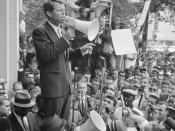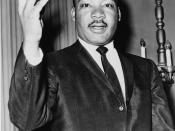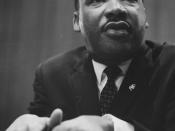1
Non-Violence as the Bigger Statement
In the documentary Eyes on the Prize, John Lewis- an attendee of the 1960 Nashville Lunch Counter Sit-In, regales the use of nonviolence in their fight for racial equality, saying "We took our seats in a very orderly, peaceful fashionâ¦We just sit there, and we continue to sit all day long... But for me, I'll tell you; it was like being involved in a holy crusade. It became a badge of honor" (PBS). The Civil Rights Movement, which began in 1954, was so deeply impactful largely in part to the unusual nature of its participant's actions against their opposition. Scarce physical tactics or retaliation was threatened against the white opposition on the black insurgent's behalf in order to achieve what they sought. Instead, the African Americans took a stance of nonviolence as their weapon of choice, hoping to reach a middle ground of peace between all of the nation's races.
Some of the historical and structural causes at the core of this stance were the guidance of Martin Luther King Jr., the organized fight to dismantle long-standing norms of racial segregation within the white communities, and the effort to raise awareness to a blind political system.
In introducing the concept of social insurgency, Doug McAdam says, "At the close of 1876-1930 period, the southern black population was only just beginning to develop the institutional strength so vital to the generation of social insurgency" (McAdam 94). Historically, black Southern Americans had experienced little to no sense of togetherness as a community; it would take someone or something with enough passion and commitment to bring them together. Obtaining a leader to push such idealistic views for the African American race is practically a requirement to incite immense social change. An organizer is the heart...


